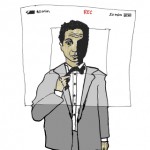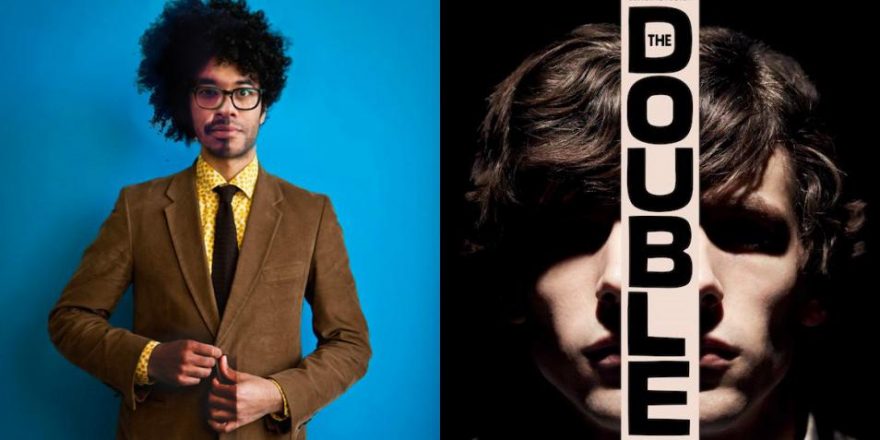Two weeks ago I received an email asking me if I would be interested in writing about Lars von Trier’s Nymphomaniac. I hadn’t seen the film yet but was dying to. I am a HUGE von Trier fan and had already been wowed by the film’s promotional campaign – the suggestive yet subtle parentheses, the orgasm faces, and the cornucopia of trailers. As is often the case with von Trier, I felt simultaneously grateful for and jealous of his brilliance. I myself had made a film called I am a Sex Addict and was dreading the inevitability that he would tackle the subject of sex far more brilliantly than I had.
I should explain that when I decided to become a filmmaker, my overriding goal was to become the greatest filmmaker of all time. To me, this was the whole point. It was about ego, not art. I saw it as a kind of contest. The point was to win – to outdo everyone else.
As my understanding of the medium deepened and I began to be awed by the vertiginous accomplishments of my predecessors, the first faint stirrings of humility began to set in. I still saw filmmaking as a contest, but I was no longer taking my victory for granted. I was beginning to see my own limitations.
In The Anxiety of Influence, Harold Bloom argues that every artist is always engaged in a struggle to outdo some predecessor. For me, Tarkovsky was always the filmmaker to beat, because his films struck me as the most spiritual. But how anyone could ever outdo him was difficult to imagine.
One night, I went to a screening of Breaking the Waves. I had seen previous von Trier films but had never been particularly impressed by them. Breaking the Waves, on the other hand, took my breath away. The lights went off and the film began. This was something I had never experienced before. I felt like I was watching, shot for shot, the film that I myself would have made had I been more brilliant, more accomplished, and more spiritually evolved. It was like having a two-hour orgasm. It was the most ecstatic viewing experience of my life. Breaking the Waves became my favorite film of all time. As far as I was concerned, von Trier had just given Tarkovsky a serious run for his money.
I felt the same way about The Idiots, von Trier’s follow-up film. Shot in accordance with the Dogma 95 “rules of chastity” that von Trier (and Dogma 95 co-founder Thomas Vinterberg) came up with as a “rescue action” to save cinema from the “golden calf” of “predictability,” this hand-held film shot with a consumer mini-DV camera was unlike anything I had ever seen. The moral anguish and political despair of that film hit very close to him. It became my new favorite film of all time.
When I heard von Trier’s next film was going to be a musical using a hundred mini-DV cameras, I was jealous. My dream had always been to one day make a Busby Berkeley-style musical and, once again, he had clearly beaten me to the punch. My fear was that his musical would be very much like the musical I myself had been envisioning, except much better. When I finally saw Dancer in the Dark, I loved the film but felt that the musical sequences didn’t live up to the promise of what a hundred cameras could capture. I couldn’t help thinking that I could have done a better job with the choreography or, at least, the choreography in my head seemed better to me than the choreography in that film.
The Five Obstructions, on the other hand, was a film I never could have imagined. The premise of the film, hiring his former mentor to remake his short film masterpiece five times with five different obstructions, was such an act of loving kindness towards Jorgen Leth while at the same time being so bold, so off-beat, so mischievous, and so inimitably von Trier. It immediately became my favorite documentary of all time. Von Trier had done it again – with his first documentary, he had both transcended and reinvented the whole genre.
Around this time, I was making my Tripping with Caveh series (of which only one episode, featuring singer/songwriter Will Oldham, was ever completed). The person in the world I most wanted to trip with was von Trier so I contacted Jorgen Leth (whom I had met at Sundance when The Five Obstructions premiered there) and obtained von Trier’s contact info. I wrote him a letter but I couldn’t bring myself to send it. I was too intimidated.
When I heard that von Trier’s next film, Dogville, would be shot on a sound stage and would use chalk outlines to represent locations, I became jealous once again. As a big fan of all things Brechtian, I’d had a very similar idea for a film but von Trier pulled it off at a level that far surpassed anything I had envisioned. I was disappointed, however, by the gratuitous violence of the ending. It reminded me of a little boy who painstakingly builds a huge tower out of popsicle sticks only to knock the whole thing down in one peremptory gesture. There’s a certain perverse thrill in doing that, but there’s also an empty feeling afterwards.
Manderlay, von Trier’s sequel to Dogville, was panned by most critics and did poorly at the box office but I loved it. Never had I seen racism explored so boldly and directly and unapologetically. Screw the wimpy politically correct critics. Von Trier was still the most interesting filmmaker in the world.
When I heard he was making a horror film called Antichrist, I was jealous once again. What a great title for a movie. And what an interesting film. The scene where Willem Dafoe’s character discovers that his wife has been deliberately putting their child’s left shoe on his right foot, and his right shoe on the left foot, is one of the great reveals in the history of cinema. Von Trier was continuing to push the envelope of the medium, but now Tarkovsky was a more palpable influence. It was becoming clear that Tarkovsky was, for him as well as for me, the filmmaker to beat.
When I finally saw Melancholia, the Tarkovsky influence was still noticeable, clearly unexorcised, but Wow! Here was von Trier taking on global warming, nuclear annihilation, and death–all in one film. Von Trier’s answer to Tarkovsky’s The Sacrifice, the ending of Melancholia ranks alongside the end of Andrei Roublev and The Devil, Probably as one of the greatest endings ever. It became my new favorite film of all time.
And then I heard he was making a film called Nymphomaniac. If I had been jealous before, I was really jealous now. What a great title. What a great subject. So commercial. So promising. So tantalizing. Several critics had called it von Trier’s magnum opus. One wrote that von Trier had recently read all of Proust and that Nymphomaniac was his response to In Search of Lost Time. I’d been working on my own Proustian opus for years, so I had some resistance to seeing von Trier’s latest masterpiece–afraid that I’d be discouraged and demoralized by von Trier’s inevitably more brilliant riff on Proust. Being asked to write about it forced me to overcome my resistance.
For those who haven’t yet seen it, von Trier’s two-part opus is about (you guessed it) a nymphomaniac, Joe (played by Charlotte Gainsbourg, with Stacy Martin as young Joe), who is beaten and left unconscious in an empty alleyway before being discovered by a Good Samaritan, Seligman (Stellan Skarsgård), who takes her to his home to convalesce. The film cuts back and forth between the framing device of the discussion between Joe and Seligman, and the story of Joe’s nymphomania.
I wanted to love it. And there were many things about the film I did love: the dialogue, the visuals (indebted, once again, to Tarkovsky), the casting of Martin, and the sheer transgressive rage that was evident throughout. I also loved the scene in which Joe prioritizes her desire to win a childish bet over a man’s desire to impregnate his wife who has been having difficulty conceiving, the scene in which a cheated-on wife brings her children to Joe’s apartment to guilt-trip their father, and the scene in which Joe gives a repressed pedophile a blow job out of compassion for the tragedy of his condition.
But my overall feeling was one of disappointment. Was this what von Trier wanted to say about human sexuality? Was this what he chose to make a five-hour film about? But I wasn’t just disappointed. There was something else going on, something far more unsettling than mere disappointment. In Nymphomaniac, von Trier blithely dispenses with any of the psychological acuity and narrative plausibility that his previous films, however Brechtian, always maintained.
I should say here that the version I watched is the truncated four-hour theatrical version, not the original five-hour director’s cut. I imagine that the five-hour version is much, much better. There were several episodes in the film that seemed truncated and underdeveloped. As a result, both the psychology and the plausibility suffer. One of the scenes deleted from the four-hour version was, apparently, an extreme close-up of female genitalia, so close as to become abstract. Now that’s a great idea for a shot. It’s so graphic as to become literally “graphic” and thereby no longer “pornographic.” I’m sure there were other amazing things lost in the abridged version.
I’ve read that von Trier approved of the four-hour version without ever actually watching it and without editing it himself. That’s odd. Why would any filmmaker go to all the trouble of writing, shooting, and editing a film only to release a version that he has not cut down himself or even bothered to watch? And why release a truncated version at all? Von Trier certainly has the clout to insist on the five-hour version. The film has already been divided into two parts. Adding half an hour to each part wouldn’t have made the film significantly less marketable
The answer, I believe, has to do with von Trier’s quest for self-acceptance. Because what’s most striking (and most radical) about Nymphomaniac isn’t the film’s relentless cataloguing of sexual and moral transgressions – it’s his almost rabid attack on the very notion of “art.”
Von Trier had already hinted at his mixed feelings about art in the Dogma 95 manifesto when he (and Vinterberg) wrote the following vow of chastity: “I swear as a director to refrain from personal taste! I am no longer an artist.” Perhaps this is the only way to outdo Tarkovsky – by repudiating the asthetic assumptions with which he operates. Because, frankly, Tarkovsky is unbeatable if one agrees to abide by the rules and protocols of spiritualist cinema – a certain notion of seriousness, narrative and psychological plausibility, and stunning cinematography. It’s like trying to outdo Bach while still obeying the rules of harmony. Forget it. The only way is to pull a John Cage maneuver and throw out harmony altogether.
Nymphomaniac represents von Trier’s latest attempt to break the rules of arthouse cinema in order to find another way, a new way, without the arguably tired and oppressive aesthetic constraints under which we all labor. He has made a valiant and even formidable attempt to dislodge Tarkovsky from the Mount Olympus of cinema and to knock down at the same time the whole crumbling edifice of good taste and manners. In Nymphomaniac, von Trier is, in a sense, shitting (or pissing or ejaculating) all over Tarkovsky, in an attempt to sully everything he stands for.
I applaud the attempt and I agree with the necessity of such a move. But I think his latest approach misses something crucial. No matter how hard he tries, it will always be a losing proposition. Because the film’s true precursor is not Proust (who followed the rules of good prose) but the Marquis de Sade. Von Trier has often exhibited a sadistic streak and this is one of the things he has been criticized for. This sadism is visible in every single one of the films I’ve mentioned with the exception of Melancholia, in which von Trier’s compassion for humanity outweighs his rage. And this sadism has been directed not only at his characters but towards his audience as well.
I, personally, love this aspect of von Trier’s work and recognize a similar sadism in my own work. Where I part ways with von Trier is in his frontal attack on art. For me, art is God. And I, personally, no longer feel any need to shit (or piss or ejaculate) on God.
Nymphomaniac resembles the work of de Sade not only in its ostensible subject matter – sexual transgression – but also in its florid 18th century enlightenment literary style and in the film’s framing device of a philosophical conversation about what the social constraints on sexual freedom should or shouldn’t be. But de Sade wrote most of his books in order to get off. He was an obsessive masturbator who was trying to turn himself on. Von Trier is also trying to get himself off but his obsession is less sexual than artistic. He is trying to turn himself on artistically and his need for artistic transgression has brought him to the current aesthetic impasse that is Nymphomaniac.
In Sex Addicts Anonymous, a sex addict is defined as someone who sexualizes their anger. Different people act out their anger in different ways. Some drink. Some gamble. Some overeat. Von Trier has been acting out his anger in his filmmaking for a long time – which is, I think, healthy and even salubrious. But at a certain point, acting out becomes a way of avoiding authentic transcendence.
The Sex Addicts Anonymous scene in Nymphomaniac is particularly telling. The 12-step program is treated with contempt and derision by von Trier who doesn’t even bother trying to get the details right or grapple in any real way with the complexity of the issues involved. In short, there is no higher power in Nymphomaniac. The notion of a higher power is, in fact, treated as a sham. People are essentially evil and there is no God.
In a recent interview, von Trier, who was raised atheist but converted to Catholicism in the wake of a spiritual experience that immediately preceded Breaking the Waves, claimed he no longer believes in God. Is there a correlation between von Trier’s recent atheism and the dip in artistic quality that Nymphomaniac represents? Another way to put it is that von Trier no longer believes in Art with a capital A. There is a slapdash quality to Nymphomaniac at the level of the writing, the casting, and the release of the truncated version that represents something new (and, in my opinion, unfortunate) in his work. He just doesn’t seem to give a shit anymore – at least not in the old way.
On the one hand, this is demoralizing. On the other hand, it makes me feel that I still have a chance to outdo him. Perhaps he has thrown in the towel of art as an act of charity to all of the other filmmakers out there who continue to be oppressed by the burdensome ideal of “great art.” Perhaps Nymphomaniac represents von Trier’s Christ moment – his willingness to take on the sins and scorn of the world for the sake of others. And in a way it is. But it’s also a sign of a certain exhaustion.
Let’s face it – the guy is insanely prolific. He has four children. He struggles with phobias and depression. If you look at recent pictures of him, it’s clear that he’s not getting enough sleep. He’s working too hard, but his ambition is such that he can’t help himself. He’s driven by something he can’t fully control, like the Marquis de Sade.
It’s difficult and undoubtedly hubristic to criticize a filmmaker of such brilliance, especially one who has demonstrated such a deep spiritual engagement throughout his career. Perhaps, one should always give von Trier the benefit of the doubt. Maybe I just don’t get what he’s doing anymore. Maybe he’s functioning at a level so high above me that I can’t even understand the terms in which he is currently operating. But I used to feel so in sync with his work and, with this film, I no longer do. Besides, I have no compass with which to view his work other than my own subjectivity.
There has always been a childishly naughty streak in von Trier’s work and personality. This is something to which I can totally relate. Fuck maturity. Fuck what other people think is proper. Fuck all norms. But where does it end? For de Sade, it ended in an insane asylum. His diaries from prison are filled with the numerological ravings of a madman. For most sex addicts, it ends in heartbreak, broken homes, or even death. Is there a way out other than through some notion of a higher power?
Charlotte Gainsbourg has said that Nymphomaniac is less a portrait of a female sex addict than a portrait of von Trier himself. He is clearly not a perfect person and, for that matter, neither was Tarkovsky (check out Tarkovsky’s Diaries if you don’t believe me). But what is truly great about von Trier is his radical embrace of his imperfections.
In a sense, Nymphomaniac represents von Trier’s even deeper embrace of his character defects than what he had achieved previously. He is trying, in his own way, to transcend all forms of ego and of co-dependence. There’s something heroic in this and it is arguably a necessary phase in the dialectic of enlightenment. But there’s a fine line between not being co-dependent and being self-indulgent, between not playing by other people’s rules and playing by the hidden rules of your own unconscious, between reinventing the form and not trying very hard.
To the extent that Nymphomaniac represents a self-portrait of von Trier, it is a self-portrait of a sex addict who has not fully recovered, who is still trying to hold on to the illusion of absolute freedom, who, like the Marquis, refuses to be ruled by any constraints whatsoever. But like Bob Dylan says: “It might be the Devil or it might be the Lord, but you’re going to have to serve somebody.” In trying to free himself from the yoke of theism, von Trier has arguably tethered himself to the yoke of his own ego. When, at the end of the film, the saint suddenly becomes a sinner and the sinner becomes a saint, and then latter kills the former, this can be seen as an allegory for a Hegelian worldview that will lead eventually to transcendence – but it is also dishearteningly facile, like the end of Dogville.
I didn’t love Nymphomaniac, but I will always love Lars von Trier. He makes me feel less alone in the world and I would still love to trip with him.






